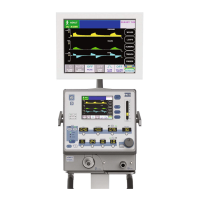OPR360US H0711
3-8
3
Unpacking, Assembly, and Safety Check
WARNING! Use water traps or heated wires in appropriate locations
in the breathing circuit to prevent water from pooling in the circuit
tubing,drainingintothepatientairwayordrainingintotheventilator.
Emptyandcleanwatertrapsasnecessary.Neverdrainthewater
backintothehumidierwaterchamber.
CautionTheventilatorisreadyforoperationonlywhenitis
completely assembled and has successfully completed the Safety
Check and Circuit Check procedures.
Safety Check Procedure
Thee360doesaself-diagnosticstestwhenpoweredON which
veriestheoperationofinternalelectronics.NewportMedical
recommends that you perform a complete Safety Check prior to
the initial use of the ventilator and at least with every preventative
maintenance interval. Use the e360 Safety Check Record at the end
of this section to record the results of each check.
Donotusethee360ventilatorifitdoesnotpasstheSafetyCheck
Procedure.
Setup and Inspection
1. Assembletheventilatorsystem.
2. InspecttheNewporte360ventilator,Newportaircompressor(if
used),ACpowercords,andverifythatthereisnoevidenceof
wear or damage which might contribute to a malfunction.
3. ConnectACpowercord(s)toproperlygroundedwallreceptacles.
4.
Inspect the high pressure air and oxygen inlet water traps on the
back of the e360 to ensure that there is no water or debris present.
5. Ensurethatthehighpressureairandoxygenhosesarermly
securedontotheventilatorinletttings.
6. Attacharecommendedtwo-limb22mmbreathingcircuitand
lters.Havea500mL(or1Lenclosed)testlungavailable.
7. Inspect the patient breathing circuit and all connections to verify
that there is no evidence of wear or damage which might result in
leaksand/orcontributetoventilatormalfunction.
Emergency Intake Valve
1. Make sure the e360 power is turned OFF on the back of the
ventilator.
2. Verifythataircanbedrawnintothepatientbreathingcircuit
through the emergency intake valve. You may create a negative
effortontheinspiratorylimbofthepatientbreathingcircuitby(1)
usinga“bellows”typetestlung,or(2)inspiringthroughabarrier
lterontheinspiratorylimbofthepatientcircuit.

